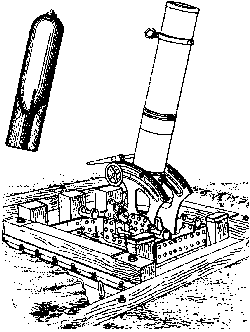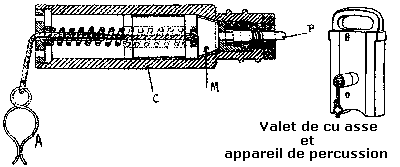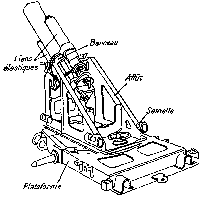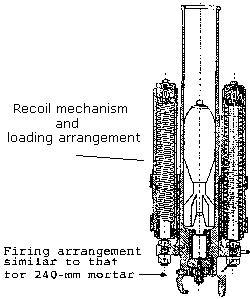|
Meanwhile the French, having studied mortars produced by sundry armament firms, including Stokes, came up with a small 58-mm (2.28-in) piece in 1915, followed by a 240-mm (9.45-in) in 1916 (see Fig. 15A and 15B), and a 150-mm (5.9-in) in 1917. Range limits of the last two were 600-2150 and 600-2000 metres respectively. These were all SBML. The French also introduced a 340-mm (13.4-in) mortar at the end of 1915, but it seems not to have been popular for by the end of the war it was no longer in use.
French SBML 240-mm (9.45-in) Mortar and bomb
Weight of projectile: 81 kg (178 lbs)
Muzzle velocity: 145 m/s (476 f/s)
|

Figure 15a
|
Rather than the fixed firing pin in the base favoured by the British the French preferred a mechanical percussion device in their heavy mortars after the style of the German minenwerfer to be described below.
| French SBML 240-mm (9.45-in) Mortar percussion mechanism
|

Figure 15b
|
Their SBML 150-mm (5.9-in) mobile mortar is of interest because it has a recoil mechanism, and seems to some extent to have been copied from the German minenwerfer. An example is shown in Fig. 16A and 16B.
French SBML 150-mm (5.9-in) Mortar
Weight of projectile: 17 kg (37 lbs)
Rate of fire: 4 RPM
|

Figure 16a
|
| Recoil mechanism, loading and firing arrangements |

Figure 16b
|
They also produced another piece which they called a 'mortar' but which in reality was a short QF 75-mm (2.95-in) field gun. See Fig. 17.
French 'Mortier 75-mm'
According to French records the equipment
here is a 'Mortier 75-mm', i.e. a 75-mm mortar. However, it is in fact a
short rifled QF 75-mm gun on a static mounting. It is included here as a
point of interest.
|

Figure 17
|
Return to top
previous |
index |
next
History index |
Home |
Wally Ruffell
|